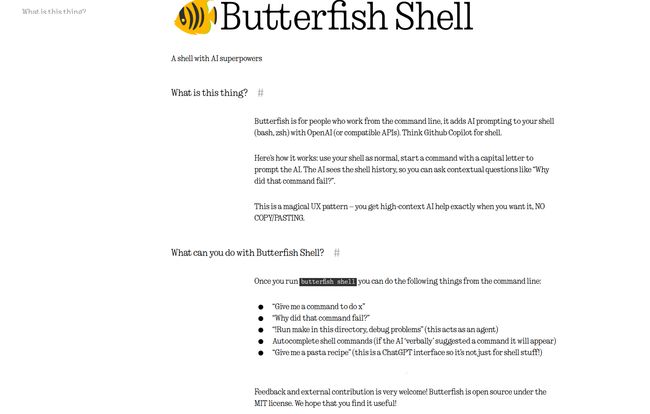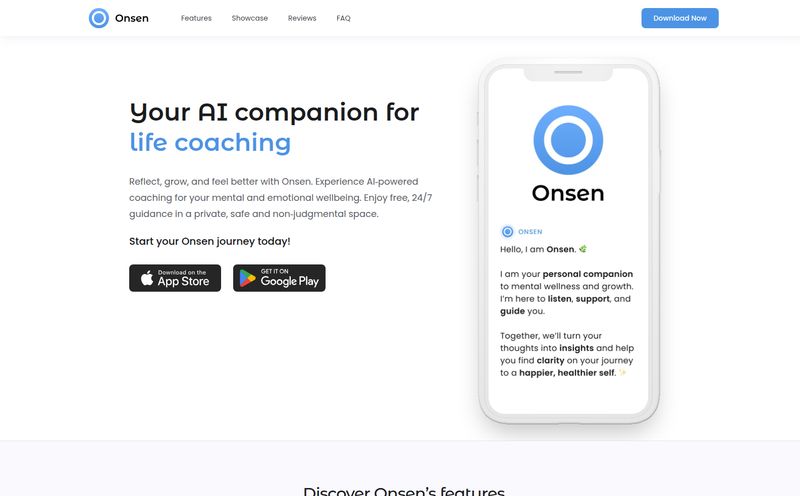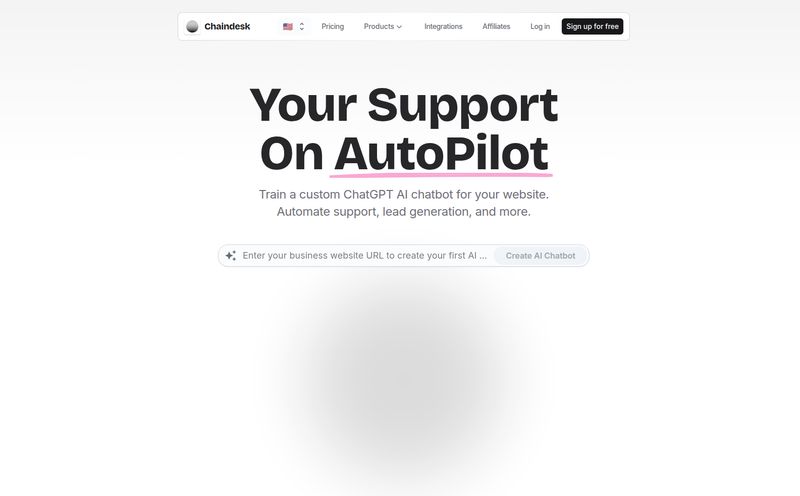I’ve spent more years than I’d like to admit staring at a blinking cursor in a terminal window. It's my happy place, my workshop, my digital Swiss Army knife. From simple `grep` commands to convoluted `awk` and `sed` one-liners that I’ll never remember again, the command line is where the magic happens. But let's be real, it can also be a source of major frustration. Who here hasn't spent ten minutes googling the right flags for `tar`?
We've seen AI creep into our IDEs with tools like GitHub Copilot, which has been a total game-changer for writing boilerplate code. So, it was only a matter of time before that same power came directly to the shell. I've been playing around with a tool that promises just that: Butterfish Shell. The name’s a bit quirky, but the premise is solid. It claims to be like Copilot, but for your command line.
So, does it live up to the hype? Or is it another tool that sounds cool but gets in the way? I installed it, hooked up my API key, and took it for a spin. Here’s what I found.
So, What is Butterfish Exactly?
In the simplest terms, Butterfish is a Python-based tool that hooks into your shell (it supports `bash` and `zsh`) and lets you prompt a Large Language Model (LLM) for help. You type what you want to do in plain English, and it spits back the command you need. No more context-switching to a browser, no more digging through man pages for a command you used once, six months ago.
But it's a bit smarter than just a simple question-and-answer bot. The real magic of Butterfish is its context-awareness. It doesn't just take your prompt; it looks at your recent command history, the files in your current directory (`ls -F`), and even your `git status`. It packages all that juicy context up and sends it along with your prompt to an AI model. This means you can ask it things like, “rename all the .jpeg files in this directory to .jpg,” and it knows what files you're talking about.
It’s like having a senior dev looking over your shoulder and whispering the right command in your ear, just when you need it.

Visit Butterfish
Getting Your Feet Wet with Butterfish
Getting it set up was surprisingly straightforward, which I always appreciate. If you've got Python and `pipx` installed (which you should, `pipx` is great for tools like this), it’s a one-liner:
pipx install butterfish
After that, you just need to hook it into your shell by adding a line to your `.zshrc` or `.bashrc` file. The final piece of the puzzle is the API key. Butterfish needs an OpenAI API key to function out of the box. You just set it as an environment variable (`export OPENAI_API_KEY='sk-...'`), and you're good to go.
The whole process took me less than five minutes. No complicated config files to start, no dependencies to wrestle with. A good start.
The Good Stuff: What I Really Like
Once it's running, you interact with it mainly through the `bf` command. I spent a few days using it for my regular work, and a few things really stood out.
The Context is Everything
I can’t overstate how useful the contextual awareness is. The other day, I was in a project directory and couldn't remember the exact command to run the test suite with coverage. I just typed:
bf 'run the tests and generate a coverage report'
And bam, it suggested the correct `pytest --cov=./ --cov-report=xml` command, knowing it was a Python project with `pytest` installed. It saw the `pyproject.toml` and my previous commands. That’s a genuine time-saver. It feels less like a generic chatbot and more like a tool that actually understands my immediate workspace.
Autosuggestion on Steroids
Butterfish has an `autosuggest` mode. This is where things get interesting and, potentially, expensive (more on that later). It works with shell plugins like `zsh-autosuggestions` to offer full command completions as you type. It's a bit more proactive than the standard `bf` prompt. To be honest, I found it a little too proactive for my taste, constantly suggesting things. But for someone new to the command line, I can see this being incredibly helpful. It’s a great way to learn commands by seeing them appear as you describe your goal.
Goal Mode: The Ambitious Assistant
Okay, this feature is wild. It's called Goal Mode, and you trigger it with `bfg`. Instead of just suggesting a command, it tries to accomplish a multi-step goal for you. You can tell it something like:
bfg 'create a new react app called my-cool-project, cd into it, and install axios'
It will then show you a plan and ask for your approval before executing each step. It's like giving an intern a set of instructions. It's incredibly powerful and gives you a glimpse into the future of human-computer interaction. It feels like you're programming your computer with plain English. But, just like with an intern, you need to watch it carefully.
Bring Your Own Model
While it defaults to OpenAI, I was thrilled to see you can point Butterfish to any OpenAI-compatible API. This is huge. I quickly configured it to use a local model I'm running with Ollama by changing the `OPENAI_API_BASE` environment variable. This means you can use open-source models like Llama 3 or Mixtral, potentially cutting down API costs to zero (besides your electricity bill, of course). It also opens the door to using faster or more specialized APIs like Groq. This flexibility is a massive win in my book.
The Caveats: Where Butterfish Stumbles
It's not all sunshine and roses, though. As with any powerful tool, there are some sharp edges you need to be aware of.
The API Cost Can Creep Up
If you're using the default OpenAI API, every prompt, and especially every `autosuggest` action, is a small transaction. These can add up fast. That context I love so much? It gets sent with every request, increasing the token count. If you're a heavy terminal user with autosuggest on, you could be looking at a surprisingly high bill at the end of the month. Using a local model mitigates this, but then you're relying on your own hardware.
Goal Mode Can Be a Loose Cannon
Remember that intern metaphor? Well, sometimes the intern gets a little too creative. Goal Mode (`bfg`) can sometimes misunderstand your intent and suggest a plan that's inefficient or, in a worst-case scenario, destructive. It always asks for confirmation before running `rm -rf /`, thank goodness, but you still need to read its plan carefully. I've found it to be a bit unreliable for really complex, nuanced tasks. It's great for straightforward setup scripts, but I wouldn't trust it to refactor my database migration files just yet.
Potential Shell Conflicts
This is a minor one, but for you power users with a `.zshrc` file that's been curated over a decade, be aware. Tools that hook this deeply into the shell can sometimes have unintended side effects or clash with other plugins. I didn’t run into any major issues, but it’s something to keep in mind. Always back up your config files before adding something new!
What About the Price?
This is the million-dollar question, isn't it? The Butterfish tool itself is open-source and free. You can install it and use it without paying the developers a dime. However, the cost comes from the API calls it makes. As I mentioned, this depends entirely on your usage and which model backend you choose.
- OpenAI: Pay-as-you-go, can get expensive with heavy use.
- Local Models (Ollama, etc.): Free, but requires decent hardware to run smoothly.
- Other APIs (Groq, Together AI): Pricing varies, but some are much cheaper than OpenAI.
Interestingly, when I tried to find an official pricing page on their site, I hit a 404 error. This just reinforces that the cost isn't for the tool, but for the AI brain you connect it to.
Who Should Use Butterfish Shell?
So, who is this for? Is it a gimmick or a genuinely useful addition to a developer's toolkit?
I think it hits a sweet spot for a few groups. For developers who are comfortable in the terminal but don't have every command memorized, it's fantastic. It bridges the gap between knowing what you want to do and knowing the exact syntax to do it. It's a brilliant productivity booster.
For beginners, it could be an incredible learning aid, especially with autosuggest. But it comes with a warning: don't become so reliant on it that you never learn the commands yourself. Use it as a teacher, not a crutch.
For hardcore command-line wizards, the value might be a bit lower. If you already have complex aliases and scripts for everything, Butterfish might just get in your way. But even for experts, it can be useful for generating those obscure one-liners for tasks you only do once a year.
Frequently Asked Questions
- Is Butterfish free to use?
- The tool itself is free and open-source. However, you will incur costs from the AI provider you connect it to, such as OpenAI, unless you use a free, self-hosted local model.
- What shells does Butterfish support?
- Currently, it officially supports `bash` and `zsh`, which cover the majority of developers on macOS and Linux.
- Can I use Butterfish with local models like Llama 3?
- Yes! This is one of its best features. By setting the `OPENAI_API_BASE` environment variable to your local server's address (e.g., one run by Ollama), you can use any OpenAI-compatible model running on your own machine.
- Is Butterfish better than the GitHub Copilot CLI?
- They are similar but have different focuses. Copilot CLI is more integrated into the GitHub ecosystem and has a `gh` command for repo-specific tasks. Butterfish feels more like a general-purpose shell assistant that excels at contextual, in-directory commands. It's a matter of preference, and you could even use both.
- How does Butterfish know the context of my project?
- It's quite clever. Before sending your prompt to the AI, it gathers information like your recent command history, the output of `ls -F` (to see files and folders), and the output of `git status` (to see changes). It sends this extra information along with your query.
- What's to stop Goal Mode from running a dangerous command?
- The primary safety mechanism is you. Goal Mode (`bfg`) presents you with a step-by-step plan and requires your explicit 'y' (yes) confirmation before executing each command. You must read and approve the plan before it does anything.
My Final Verdict
So, is Butterfish a permanent addition to my workflow? For now, yes. I've disabled the aggressive `autosuggest` to keep costs down and am mainly using the standard `bf` command with a mix of OpenAI for complex stuff and a local model for simpler queries. It's not perfect, and Goal Mode is more of a fun novelty for me right now than a reliable workhorse.
But the ability to stay in the terminal and get a context-aware command suggestion is undeniably powerful. It smooths out the little bumps in my day, the moments of friction where I'd normally have to open a browser and break my flow. It won't replace the need to learn how your shell works, but it’s an exceptionally smart and well-designed assistant. If you live in the command line, I'd say it's definitely worth a try. Just keep an eye on your API usage.



